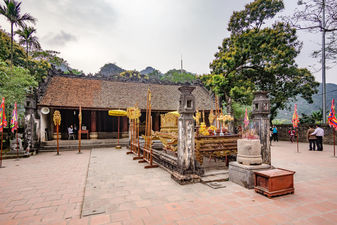
NINH BINH
VIETNAM
King Dinh, King Le Temple in Hoa Lu
According to historical documents, the ancient capital of Hoa Lu – Ninh Binh was once a magnificent, majestic palace surrounded by arched stone mountain with spectacular views of the lakes, rammer… making the landscape in this place both charming, gentle and mysterious.
Over more than 10 centuries, the ancient capital of Hoa Lu was almost destroyed, ruined. Currently, Hoa Lu relic has nearly 30 monuments, in which, 2 typical relics are temple of King Dinh and temple of King Le. Around this area, there are a number of ancient temples, pagodas thousands of years old, they are also a part of the architecture in the main palace, each one has its own appeal.
To commemorate the merit of national heroes, the Hau Le (literally, the Later Le) dynasty restored, rebuilt the temple of King Dinh worshipping Dinh Tien Hoang. The temple was built in the style of “nội công ngoại quốc” (internal shape looks like Chinese character “Cong” 工 and external shape looks like character “quoc” 国), a few hundred meters from Ma Yen mountain. Over four centuries, the temple has retained its majesty, taciturn with works such as: Ngọ môn quan (Gate of Noon), lotus pond, Gia mountain, flower gardens, outer and inner alter- certains.
The temple has three sections: the exterior area is the sanctum, the middle section is called Thien Huong worshipping four officials of the Dinh dynasty: Dinh Dien, Nguyen Bac, Trinh Tu, Luu Co. In the innermost section, Dinh Tien Hoang statue is worshipped in the center, in two sides, there are altars of 3 princes Dinh Lien, Dinh Toan and Dinh Hang Lang. The walkways, gate, the walls of the temple are covered with moss of the time. There are lush gardens of fruit around the temple. In front of the shrine has a Long Sang (King’s bed) made from monolithic stone with a couple of young lion statue in two sides. The decoration, flowers, animals … are carved very around the bed.
The temple of King Le where King Le Dai Hanh (i.e. Le Hoan) is worshipped is not very far from King Dinh temple. He was a solid general in Dinh Dynasty, he deserved credit for pacifying, unifying the country, so he was appointed Thap Dao Tuong Quan (the highest ranking officials of Dinh dynasty) by King Dinh Tien Hoang. Le Hoan became the king after the death of King Dinh. He was the first king of the Tien Le (Early Le) Dynasty. King Le Temple is smaller and more simple than that of King Dinh. In the sanctum of the temple, there are three statues: Emperor Le Dai Hanh sitting on the throne in the center, Queen Duong Van Nga in the left and King Le Long Dinh in the right. The temple still retains many vestiges of ancient architecture with ornate virtuosity carved array. Here, people have found the remains of the old palace and some ancient pottery. These precious objects are kept in the museum room of the temple.
Just in front of the temple of King Dinh is Ma Yen mountain which is shaped like the saddle. After climbing 265 steps to the top of the mountain, visitors will reach the tomb of King Dinh. King Dinh Tien Hoang’s shrine was built from gray stone, located on a mountain surrounded by fresh trees. After incensing, from there, visitors can zoom eye to see relics of Hoa Lu which is as beautiful as an ink painting.
Visiting Hoa Lu, visitors will be immersed in the beauty of landscapes that the nature gives this sacred land, admire the ruins left in the ancient capital of Hoa Lu; learn more about architecture, art, economics, culture and society of Vietnam at that time. This is an opportunity for people to appreciate the predecessors, listen to interesting stories about the simple peasant kings – the national hero had the building and defending the country.
Hoa Lu ancient capital is not only a especially important national relic, but also one of the three area creating Trang An landscape complex, the landmark which has been formally enrolled in the UNESCO list of World Heritage on 23rd June, 2014.
Courtesy of Vietnamdhtravel

























